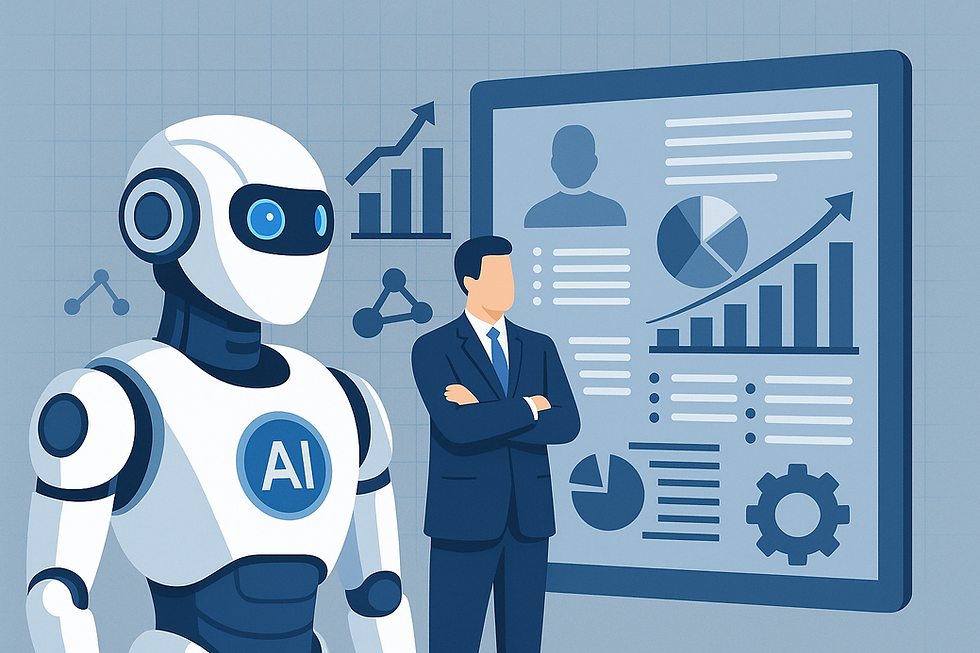Industry Snapshots: How Leadership Evolves by Sector in a Bot-Driven Era
- Matthew Jensen
- Jul 10
- 4 min read
Artificial intelligence is not transforming the workplace in one uniform way. Rather, its impact varies dramatically across sectors. Leadership in a hospital looks very different from leadership in a retail chain, a law firm, or a construction site. While the core challenge is universal—how to lead when bots become part of the team—the solutions are deeply contextual.
This article explores how AI integration is reshaping leadership in five major industries:

healthcare, legal, construction, retail, and finance. Each faces distinct use cases, risks, and organizational cultures. To succeed, leaders must adopt sector-specific approaches that balance control, trust, and augmentation.
1. Healthcare: Clinical Decision Support Bots
AI Integration
In healthcare, AI tools assist with diagnostics, suggest treatment protocols, and predict patient deterioration. Systems like IBM Watson Health and Aidoc support doctors by surfacing insights from imaging scans, patient histories, and clinical literature.
Leadership Shifts
From Authority to Collaboration: Physicians traditionally held decision-making authority. AI disrupts this by becoming a co-diagnostician. Leaders must help clinicians view AI as a partner, not a threat.
From Autonomy to Accountability: AI introduces shared responsibility. Leaders must clarify when to trust AI versus override it, and who is accountable when decisions go wrong.
From Rote to Relationship: As bots handle routine cases, human providers focus more on complex care, empathy, and family communication. Leadership must reinforce this emotional labor as core to medical excellence.
Key Competencies
Clinical AI literacy
Ethical foresight and data governance
Building interdisciplinary trust among doctors, data scientists, and administrators
2. Legal: Automated Discovery Tools
AI Integration
AI tools now comb through legal documents to find relevant case law, draft briefs, or summarize contracts. Tools like Everlaw, Luminance, and Lawgeex reduce the manual burden of legal research and compliance.
Leadership Shifts
From Craft to Curation: Legal work once depended on deep domain expertise. Now, leaders must guide teams on how to curate, interpret, and validate AI-generated legal materials.
From Billable Hours to Value Delivery: Automation pressures traditional revenue models. Leaders must rethink compensation and productivity frameworks.
From Guarding to Guiding: Lawyers are trained to minimize risk. But AI introduces probabilistic, not deterministic, logic. Leaders must embrace ambiguity and steer through evolving precedents.
Key Competencies
Tech-enabled legal strategy
Client transparency around AI use
Cross-functional fluency with IT, compliance, and ethics teams
3. Construction: Autonomous Equipment and Site Monitoring
AI Integration
AI-enabled machines excavate sites, pour concrete, and scan for structural errors. Drones and sensors gather data in real time. Platforms like Built Robotics and OpenSpace are redefining job sites.
Leadership Shifts
From Foreman to System Integrator: Leaders once directed people and schedules. Now, they orchestrate humans, machines, and IoT data systems.
From Intuition to Insight: Decisions are increasingly driven by AI-powered forecasting (e.g., weather, material delivery timing). Leaders must balance boots-on-ground experience with digital guidance.
From Training to Reskilling: As machines take over physical labor, leaders must reskill teams for maintenance, monitoring, and control systems.
Key Competencies
Operational data interpretation
Safety management in human-machine environments
Vendor and tech partner coordination
4. Retail: Robotic Inventory and Customer Experience Bots
AI Integration
Robots manage inventory, automate replenishment, and guide customers in-store. AI predicts demand, personalizes recommendations, and adjusts pricing dynamically. Examples include Bossa Nova robots and Salesforce Einstein.
Leadership Shifts
From Floor Manager to Experience Designer: Leaders move from supervising staff to orchestrating physical and digital customer journeys.
From Staffing to Storytelling: AI enables leaner staffing. Leaders must now invest in human-centered roles that embody the brand (e.g., concierges, stylists).
From Static to Dynamic Management: With AI feeding real-time data on foot traffic, conversion rates, and inventory, leaders must make agile, hour-by-hour decisions.
Key Competencies
Retail tech fluency
Real-time decision-making and analytics
Culture-building among hybrid human-bot teams
5. Finance: Robo-Advisors and Predictive Analytics
AI Integration
Platforms like Betterment, Wealthfront, and Bloomberg Terminal AI assist with portfolio management, market prediction, and risk assessment. Internal bots analyze compliance violations and model macroeconomic trends.
Leadership Shifts
From Gut Instinct to Data-Driven Strategy: Traders and analysts must shift from hunches to models. Leaders must create frameworks to validate AI recommendations without over-reliance.
From Exclusivity to Accessibility: AI democratizes financial services. Leaders must rethink customer segmentation and compliance at scale.
From Individual Performance to System Optimization: Performance is now a function of human-AI orchestration. Leaders manage ecosystems, not just individuals.
Key Competencies
Quantitative acumen
Algorithmic oversight and model transparency
Customer trust and ethical investment leadership
Cross-Sector Patterns in Leadership Evolution
Despite differences, several common themes emerge across industries:
1. AI Literacy Becomes Essential
Leaders don’t need to code but must understand how AI works, where it can fail, and how to manage it. AI ignorance is no longer tenable.
2. Trust Management Replaces Micromanagement
Leaders must trust machines without blindly delegating. Oversight, not overcontrol, is the name of the game.
3. Ethics Becomes a Leadership Function
Whether in healthcare diagnoses or legal discovery, leaders must own the consequences of AI decisions. Ethical literacy becomes core to C-suite roles.
4. Reskilling Is a Leadership Priority
Human roles are not disappearing but shifting. Leaders must invest in learning cultures, upskilling, and career transitions.
5. Storytelling and Vision Rise in Value
As machines handle data and process, leaders are valued for what bots can’t do: inspire, connect, and create shared purpose.
Conclusion
Leadership in a bot-driven era is not one-size-fits-all. It is nuanced, sector-specific, and dynamic. But across the board, leaders must evolve from task-focused managers to system architects, culture stewards, and ethical decision-makers.
The next generation of leaders won’t just lead people. They will lead intelligent ecosystems.
This is the eighth article in our series "Leadership in the Age of AI Bots." Next, we’ll turn inward: How do companies embed these new leadership principles into business strategy and planning frameworks? And what does it look like to design for human-machine collaboration from the ground up?



